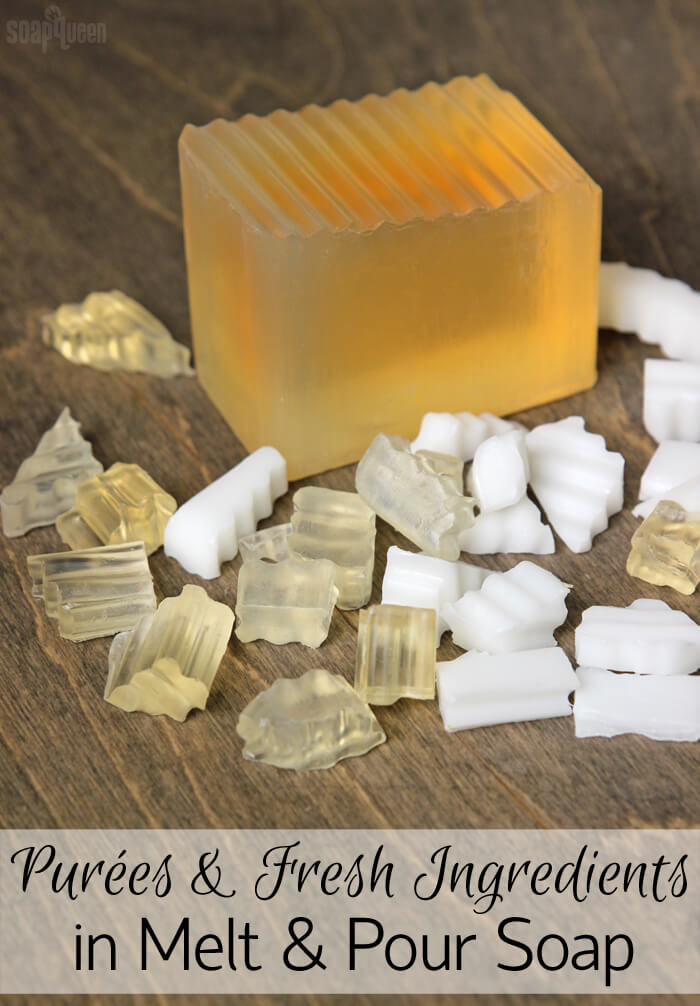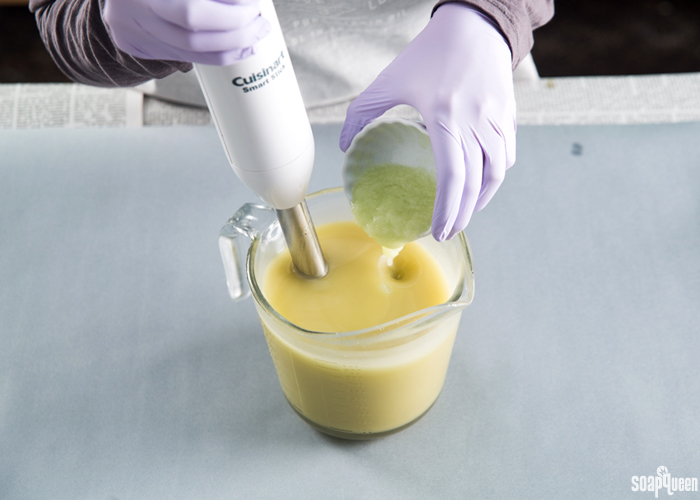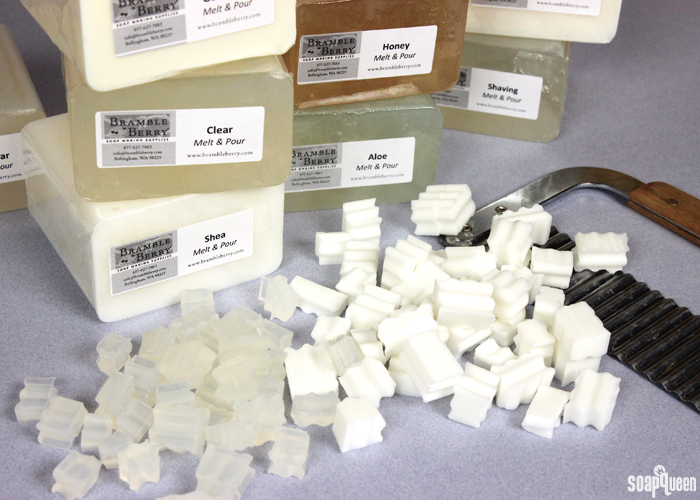
I love how a block of melt and pour soap base can be transformed into so many things. If you take a peek at the melt and pour section of this blog, you can see just how many possibilities there are. From color and fragrance to exfoliants and embeds, there are so many design options. It’s easy to understand why crafters of all skill levels enjoy it!
Despite the vast possibilities for melt and pour, there are a few additives that don’t work well. Fresh ingredients like purees and milk are at the top of the list. To understand why these ingredients don’t work, it’s important to understand what melt and pour soap is. Melt and pour soap is ready-made soap that has gone through the saponification process. That means sodium hydroxide lye, oils, glycerin (and sometimes other ingredients) were combined together to make the base – just like making cold process soap! If you’re unfamiliar with saponification, this video explains the process further.
The fact that saponification has already occurred in melt and pour soap is what makes melt and pour soap “easy.” You don’t have to worry about working with lye. Melt and pour soap is ready to use once fully cooled and hardened, so it’s fast too. No cure time is needed for melt and pour. But, because saponification has already occurred, it means that you don’t have as much control over the ingredients in the soap. Ingredients that require saponification to become part of the soap (lye, oils, butters, purees, milk, eggs, etc) don’t work well when added to melt and pour.
So, why can you use fresh ingredients (purees, milk, etc.) in cold process soap, and not melt and pour? When you add fresh ingredients during the cold process soaping process, those ingredients get extra scalded and burned because of the heat and the high pH of the fresh soap. That high pH and heat scorch most anything that was once alive with the possibility of growing nasties. The extra ingredients also go through the saponification process along with the lye and oils. But in melt and pour, that chemical process has already occurred. It’s too late to properly incorporate fresh ingredients.
 Purees can be added to cold process soap batter because they will go through the saponification process.
Purees can be added to cold process soap batter because they will go through the saponification process.
Think of it this way: you made a cake, and take it out of the oven to cool. Then you realize, you forgot the eggs. Dang! Since the cake has been baked and is now cake (and not cake batter), it’s too late to add eggs. The eggs won’t mix in. It’s too late for the eggs to be turned into cake. You can still decorate the cake with frosting, sprinkles and top it with candles. But, you can’t add ingredients into the cake that require baking.
Like the cake, it’s too late to add fresh ingredients to melt and pour soap base. Melt and pour soap is fully made and is “out of the oven.” Like decorating the cake, you can still add fragrance, color, sparkle and more to the soap. But you can’t add an ingredient that needs to go through the saponification process.
What will happen if you do add fresh ingredients to melt and pour? Well, probably nothing for a while. But eventually, those ingredients will go bad. Adding a fruit/veggie purée to melt and pour soap is like leaving the purée out on the counter. Eventually it will turn brown and grow mold. The same is true for milk. Adding milk (or even milk powder) to melt and pour soap is like leaving a carton of milk on the counter. Eventually the milk will spoil. If you were to add raw eggs to your already baked cake, those eggs would go rancid very quickly.
 Some melt and pour bases already contain fresh ingredients like milk, honey and aloe vera liquid. Learn more about the various bases here.
Some melt and pour bases already contain fresh ingredients like milk, honey and aloe vera liquid. Learn more about the various bases here.
Luckily, there is a way to enjoy fresh ingredients into melt and pour projects. Some bases contain coveted fresh ingredients like milk and honey. The SFIC Goat Milk Melt and Pour Base contains 10% liquid goat milk. In the SFIC Honey Melt and Pour Soap, honey is the fifth ingredient which gives it a lovely, warm color. The SFIC Aloe Vera Melt and Pour contains 5% aloe vera gel. These ingredients are added during the saponification process, so they won’t spoil. =) Browse all the melt and pour bases here.
If you prefer adding those ingredients yourself and want full control over the recipe, cold process soap is the way to go. If you’ve never made cold process soap before, I recommend starting with some very basic recipes before working purées, milk and other fresh ingredients. Fresh ingredients complicate the process, so it’s good to get the basics under your belt first. If you’d like to learn more about working with fresh ingredients in cold process soap, check out the blog posts below!
How to Add Purees to Cold Process Soap
How to Add Lye to Milk for Cold Process Soap
Adding Honey to Cold Process Soap: Tips, Tricks & Recipe
How to Use Honey in Bath & Body Products
Buttermilk Bastille Baby Bar on Soap Queen TV
